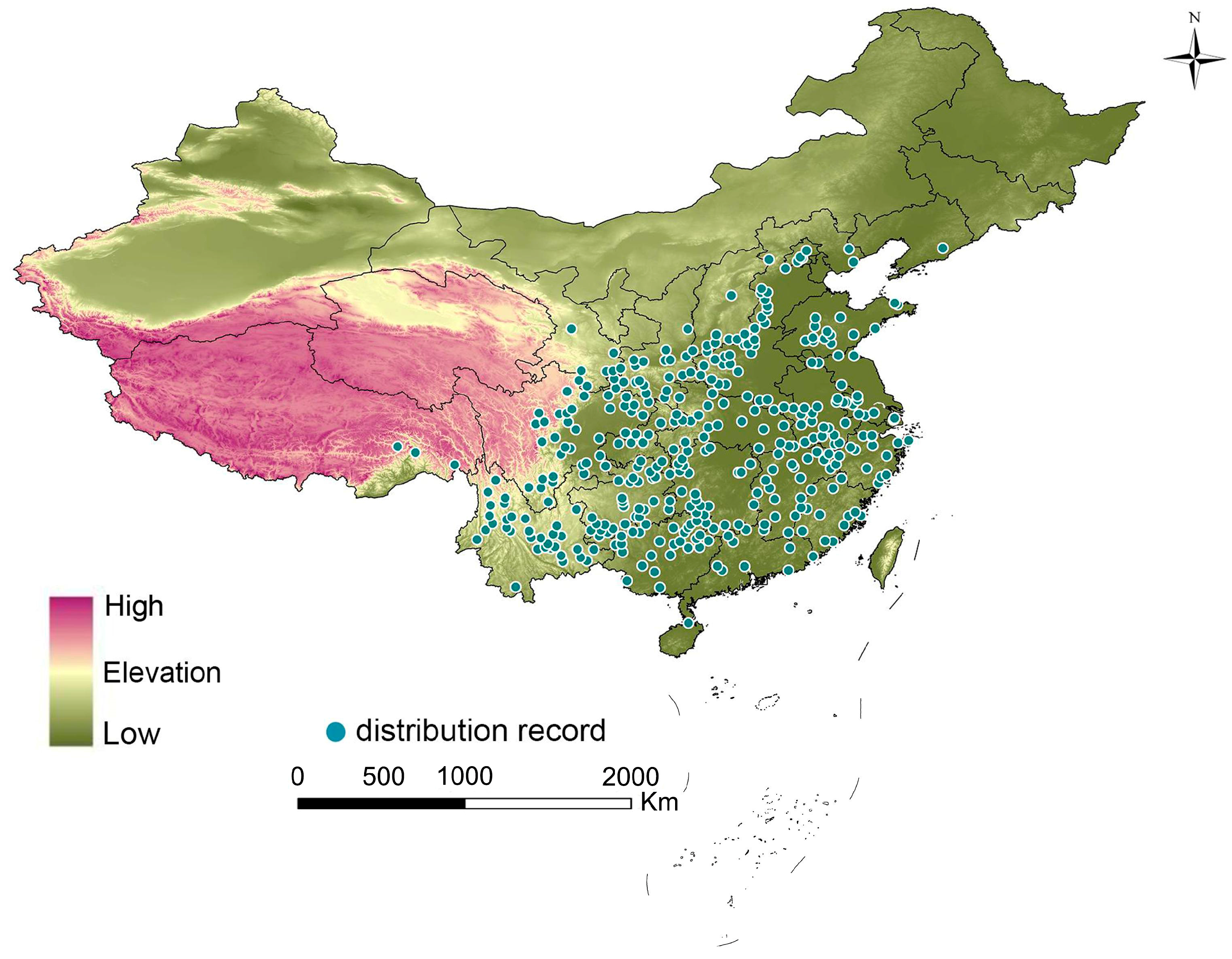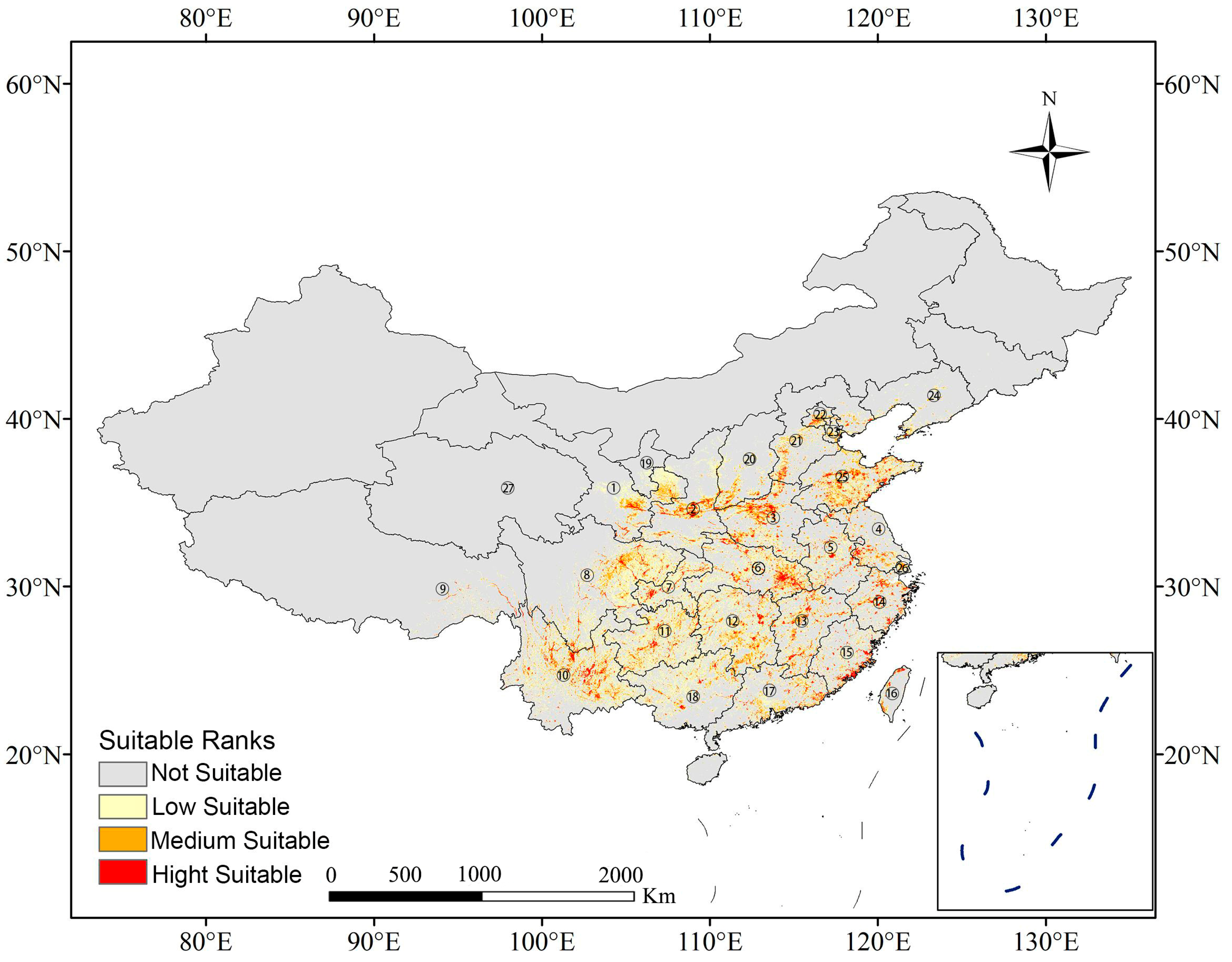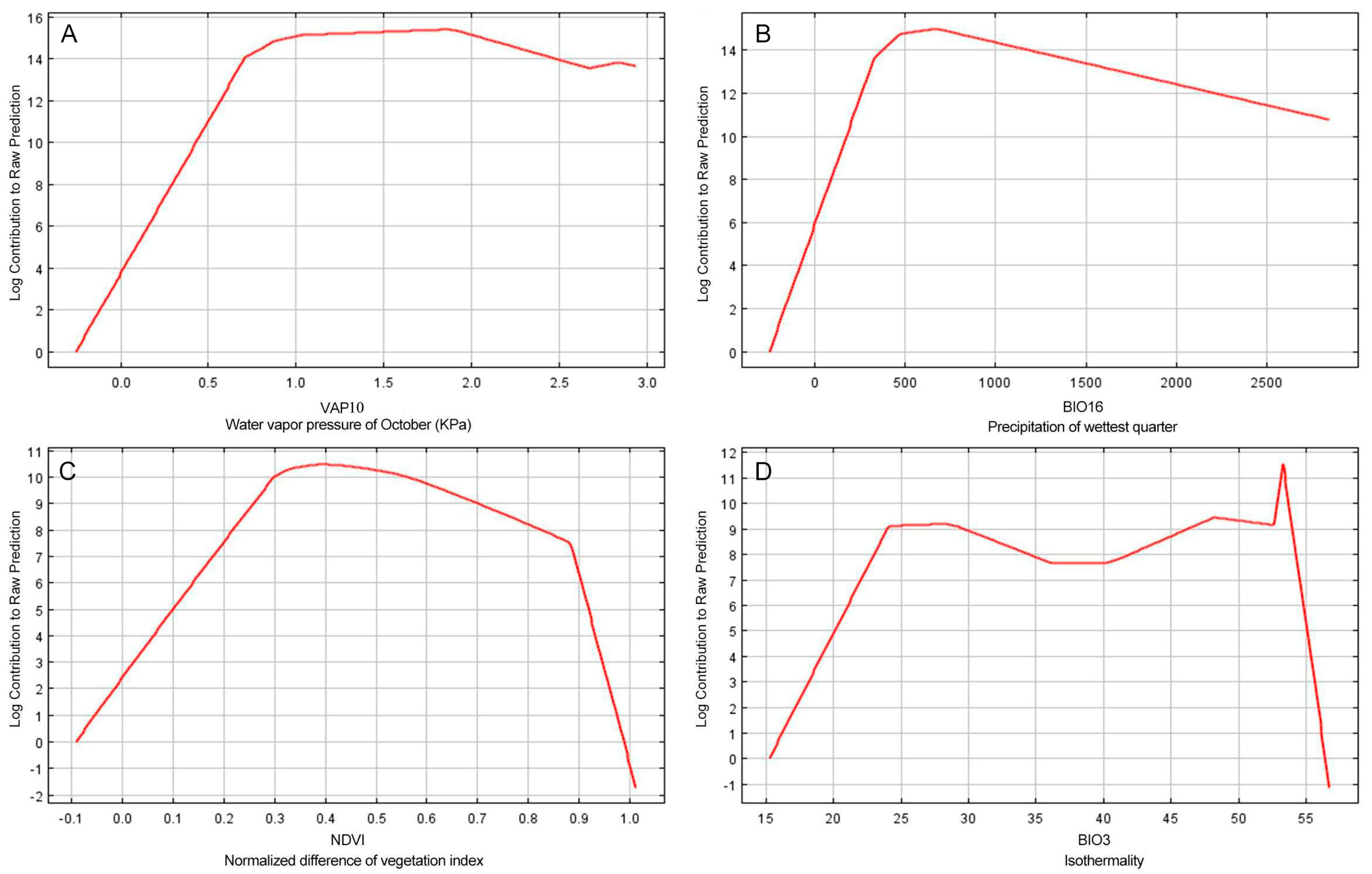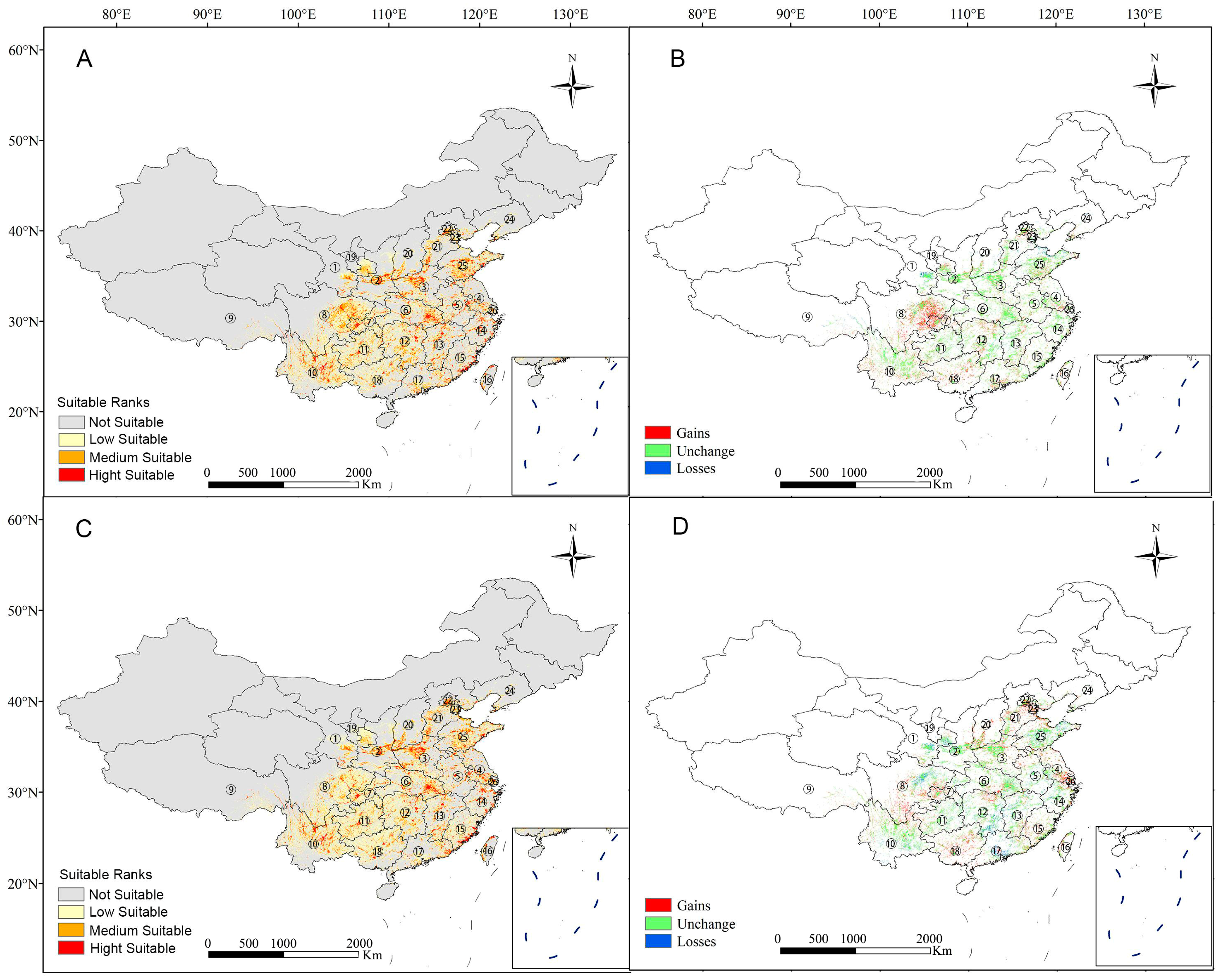MaxEnt Modeling and the Impact of Climate Change on Pistacia chinensis Bunge Habitat Suitability Variations in China
Abstract
1. Introduction
2. Materials and Methods
2.1. Species Occurrence Data
2.2. Environmental Parameters
2.3. Model Simulation
3. Results
3.1. Evaluate the Model Performance of Pistacia chinensis
3.2. Regions for the Potential Distribution of Pistacia chinensis
3.3. Critical Environmental Factors Influencing Geographical Location of Pistacia chinensis
3.4. Future Alterations of Appropriate Habitat Area
4. Discussion
4.1. Distribution and Prediction of Pistacia chinensis
4.2. Environmental Factors Affecting Pistacia chinensis Distribution
4.3. Impact of Climate Change on Pistacia chinensis Distribution as Well as Related Forest Ecosystems
4.4. Implications for Conservation Plans
4.5. Limitations of Modeling and Future Research Directions
5. Conclusions
Author Contributions
Funding
Data Availability Statement
Acknowledgments
Conflicts of Interest
References
- Dusenge, M.E.; Duarte, A.G.; Way, D.A. Plant carbon metabolism and climate change: Elevated CO2 and temperature impacts on photosynthesis, photorespiration and respiration. New Phytol. 2019, 221, 32–49. [Google Scholar] [CrossRef] [PubMed]
- Van Leeuwen, C.; Destrac-Irvine, A.; Dubernet, M.; Duchêne, E.; Gowdy, M.; Marguerit, E.; Pieri, P.; Parker, A.; De Resseguier, L.; Ollat, N. An update on the impact of climate change in viticulture and potential adaptations. Agronomy 2019, 9, 514. [Google Scholar] [CrossRef]
- Pareek, A.; Dhankher, O.P.; Foyer, C.H. Mitigating the impact of climate change on plant productivity and ecosystem sustainability. J. Exp. Bot. 2020, 71, 451–456. [Google Scholar] [CrossRef] [PubMed]
- Zhang, K.; Liu, H.; Pan, H.; Shi, W.; Zhao, Y.; Li, S.; Liu, J.; Tao, J. Shifts in potential geographical distribution of Pterocarya stenoptera under climate change scenarios in China. Ecol. Evol. 2020, 10, 4828–4837. [Google Scholar] [CrossRef] [PubMed]
- Zhang, K.; Yao, L.; Meng, J.; Tao, J. Maxent modeling for predicting the potential geographical distribution of two peony species under climate change. Sci. Total Environ. 2018, 634, 1326–1334. [Google Scholar] [CrossRef] [PubMed]
- Hannah, L.; Midgley, G.F.; Millar, D. Climate change-integrated conservation strategies. Glob. Ecol. Biogeogr. 2002, 11, 485–495. [Google Scholar] [CrossRef]
- Wang, J.; Cao, B.; Bai, C.; Zhang, L.; Che, L. Potential distribution prediction and suitability evaluation of Fritillaria cirrhosa D. Don based on maxent modeling and GIS. Bull. Bot. Res. 2014, 34, 642–649. [Google Scholar]
- Deb, J.C.; Rahman, H.T.; Roy, A. Freshwater swamp forest trees of Bangladesh face extinction risk from climate change. Wetlands 2016, 36, 323–334. [Google Scholar] [CrossRef]
- Huang, Z.; Xie, L.; Wang, H.; Zhong, J.; Li, Y.; Liu, J.; Ou, Z.; Liang, X.; Li, Y.; Huang, H.; et al. Geographic distribution and impacts of climate change on the suitable habitats of Zingiber species in China. Ind. Crops Prod. 2019, 138, 111429. [Google Scholar] [CrossRef]
- Colyn, R.B.; Ehlers Smith, D.A.; Ehlers Smith, Y.C.; Smit-Robinson, H.; Downs, C.T. Predicted distributions of avian specialists: A framework for conservation of endangered forests under future climates. Divers. Distrib. 2020, 26, 652–667. [Google Scholar] [CrossRef]
- Kumar, D.; Pandey, A.; Rawat, S.; Joshi, M.; Bajpai, R.; Upreti, D.K.; Singh, S.P. Predicting the distributional range shifts of Rhizocarpon geographicum (L.) DC. in Indian Himalayan Region under future climate scenarios. Environ. Sci. Pollut. Res. 2022, 29, 61579–61593. [Google Scholar] [CrossRef] [PubMed]
- Anderson, R.P.; Lew, D.; Peterson, A.T. Evaluating predictive models of species’ distributions: Criteria for selecting optimal models. Ecol. Modell. 2003, 162, 211–232. [Google Scholar] [CrossRef]
- Elith, J.; Kearney, M.; Phillips, S. The art of modelling range-shifting species. Methods Ecol. Evol. 2010, 1, 330–342. [Google Scholar] [CrossRef]
- Merow, C.; Smith, M.J.; Silander Jr, J.A. A practical guide to MaxEnt for modeling species’ distributions: What it does, and why inputs and settings matter. Ecography 2013, 36, 1058–1069. [Google Scholar] [CrossRef]
- Nzei, J.M.; Ngarega, B.K.; Mwanzia, V.M.; Kurauka, J.K.; Wang, Q.F.; Chen, J.M.; Li, Z.Z.; Pan, C. Assessment of Climate Change and Land Use Effects on Water Lily (Nymphaea L.) Habitat Suitability in South America. Diversity 2022, 14, 830. [Google Scholar] [CrossRef]
- Pearson, R.G.; Thuiller, W.; Araújo, M.B.; Martinez-Meyer, E.; Brotons, L.; McClean, C.; Miles, L.; Segurado, P.; Dawson, T.P.; Lees, D.C. Model-based uncertainty in species range prediction. J. Biogeogr. 2006, 33, 1704–1711. [Google Scholar] [CrossRef]
- Peterson, A.T.; Papes, M.; Eaton, M. Transferability and model evaluation in ecological niche modeling: A comparison of GARP and MaxEnt. Ecography 2007, 30, 550–560. [Google Scholar] [CrossRef]
- Park, J.J.; Mo, H.H.; Lee, G.S.; Lee, S.E.; Lee, J.H.; Cho, K. Predicting the potential geographic distribution of Thrips palmi in Korea, using the CLIMEX model. Entomol. Res. 2014, 44, 47–57. [Google Scholar] [CrossRef]
- Carpenter, G.; Gillison, A.N.; Winter, J. DOMAIN: A flexible modelling procedure for mapping potential distributions of plants and animals. Biodivers. Conserv. 1993, 2, 667–680. [Google Scholar] [CrossRef]
- Phillips, S.J.; Anderson, R.P.; Schapire, R.E. Maximum entropy modeling of species geographic distributions. Ecol. Modell. 2006, 190, 231–259. [Google Scholar] [CrossRef]
- Yang, J.; Huang, Y.; Jiang, X.; Chen, H.; Liu, M.; Wang, R. Potential geographical distribution of the edangred plant Isoetes under human activities using MaxEnt and GARP. Glob. Ecol. Conserv. 2022, 38, e02186. [Google Scholar] [CrossRef]
- Hirzel, A.H.; Hausser, J.; Chessel, D.; Perrin, N. Ecological-niche factor analysis: How to compute habitat-suitability maps without absence data? Ecology 2002, 83, 2027–2036. [Google Scholar] [CrossRef]
- Pearson, R.G.; Dawson, T.P. Predicting the impacts of climate change on the distribution of species: Are bioclimate envelope models useful? Glob. Ecol. Biogeogr. 2003, 12, 361–371. [Google Scholar] [CrossRef]
- Elith, J.; Graham, C.H.; Anderson, R.P.; Dudík, M.; Ferrier, S.; Guisan, A.; Hijmans, R.J.; Huettmann, F.; Leathwick, J.R.; Lehmann, A. Novel methods improve prediction of species’ distributions from occurrence data. Ecography 2006, 29, 129–151. [Google Scholar] [CrossRef]
- Min, T.; Barfod, A. Anacardiaceae. In Flora of China; Hong, D.Y., Pan, K.Y., Turland, N.J., Eds.; Science Press and Missouri Botanical Garden Press: Beijing, China; St. Louis, MO, USA, 1980; Volume 11, p. 345. [Google Scholar]
- Liu, Y.; Yao, Y.; Luo, X.; Zeng, H.; Zhai, X. Effects of heat stress on physiological and biochemical characters of several tree species. J. Henan Agric. Sci. 2011, 40, 126–128. [Google Scholar]
- Dong, Z.; Wu, R.; Wu, X. Effects of Different Treatments on Pistacia chinensis seedling growth. J. Anhui Agric. Sci. 2015, 43, 208–210. [Google Scholar]
- Huang, C. Effects of Different seedling breeding methods on Pistacia chinensis seedling growth. Jiangsu Agric. Sci. 2011, 39, 197–198. [Google Scholar]
- Chen, J.; Ma, L.; Duan, J.; Peng, Z.; Jia, L. Studied of characteristics of growth and water consumption of Pistacia chinensis Bunge under different soil water conditions. J. Cent. South Univ. Forestry Technol. 2014, 34, 68–72+77. [Google Scholar]
- CVH.ac.cn. Available online: https://www.cvh.ac.cn (accessed on 22 December 2022).
- Tropicos.org. Missouri Botanical Garden. Available online: https://tropicos.org (accessed on 22 December 2022).
- GBIF.org. GBIF Home Page. 2023. Available online: https://www.gbif.org/species/3190586 (accessed on 22 December 2022).
- Fick, S.E.; Hijmans, R.J. WorldClim 2: New 1-km spatial resolution climate surfaces for global land areas. Int. J. Climatol. 2017, 37, 4302–4315. [Google Scholar] [CrossRef]
- RESDC Website. Available online: http://www.resdc.cn/Default.aspx (accessed on 23 December 2022).
- Nachtergaele, F.O.; van Velthuizen, H.; Verelst, L.; Wiberg, D.; Batjes, N.H.; Dijkshoorn, J.A.; van Engelen, V.W.P.; Fischer, G.; Jones, A.; Montanarella, L.; et al. Harmonized World Soil Database (version 1.2). Food and Agriculture Organization of the UN, International Institute for Applied Systems Analysis, ISRIC—World Soil Information, Institute of Soil Science—Chinese Academy of Sciences, Joint Research Centre of the EC. 2012. Available online: https://www.fao.org/soils-portal/data-hub/soil-maps-and-databases/harmonized-world-soil-database-v12/en/ (accessed on 22 December 2022).
- Wu, T.; Song, L.; Li, W.; Wang, Z.; Zhang, H.; Xin, X.; Zhou, M. An overview of BCC climate system model development and application for climate change studies. J. Meteorol. Res. 2014, 28, 34–56. [Google Scholar] [CrossRef]
- Hijmans, R.J.; Cameron, S.E.; Parra, J.L.; Jones, P.G.; Jarvis, A. Very high resolution interpolated climate surfaces for global land areas. Int. J. Climatol. 2005, 25, 1965–1978. [Google Scholar] [CrossRef]
- Phillips, S.J.; Dudík, M.; Elith, J.; Graham, C.H.; Lehmann, A.; Leathwick, J.; Ferrier, S. Sample selection bias and presence-only distribution models: Implications for background and pseudo-absence data. Ecol. Appl. 2009, 19, 181–197. [Google Scholar] [CrossRef]
- Deb, J.C.; Phinn, S.; Butt, N.; McAlpin, C.A. The impact of climate change on the distribution of two threatened Dipterocarp trees. Ecol. Evol. 2017, 7, 2238–2248. [Google Scholar] [CrossRef]
- Ortega-Huerta, M.A.; Peterson, A.T. Modeling ecological niches and predicting geographic distributions: A test of six presence-only methods. Rev. Mex. Biodivers. 2008, 79, 205–216. [Google Scholar]
- López-Collado, J.; López-Arroyo, J.I.; Robles-García, P.L.; Márquez-Santos, M. Geographic distribution of habitat, development, and population growth rates of the Asian citrus psyllid, Diaphorina citri, in Mexico. J. Insect Sci. 2013, 13, 114. [Google Scholar] [CrossRef]
- Allouche, O.; Tsoar, A.; Kadmon, R. Assessing the accuracy of species distribution models: Prevalence, kappa and the true skill statistic (TSS). J. Appl. Ecol. 2006, 43, 1223–1232. [Google Scholar] [CrossRef]
- Yang, Z.; Gao, J.; Zhou, C.; Shi, P.; Zhao, L.; Shen, W.; Ouyang, H. Spatio-temporal changes of NDVI and its relation with climatic variables in the source regions of the Yangtze and Yellow rivers. J. Geogr. Sci. 2011, 21, 979–993. [Google Scholar] [CrossRef]
- Zhang, K.; Zhang, Y.; Zhou, C.; Meng, J.; Sun, J.; Zhou, T.; Tao, J. Impact of climate factors on future distributions of Paeonia ostii across China estimated by MaxEnt. Ecol. Inform. 2019, 50, 62–67. [Google Scholar] [CrossRef]
- Appleby, R.F.; Davies, W.J. A possible evaporation site in the guard cell wall and the influence of leaf structure on the humidity response by stomata of woody plants. Oecologia 1983, 56, 30–40. [Google Scholar] [CrossRef] [PubMed]
- Grossiord, C.; Buckley, T.N.; Cernusak, L.A.; Novick, K.A.; Poulter, B.; Siegwolf, R.T.W.; Sperry, J.S.; McDowell, N.G. Plant responses to rising vapor pressure deficit. New Phytol. 2020, 226, 1550–1566. [Google Scholar] [CrossRef] [PubMed]
- Tang, Y.; Zhang, K.; Zhang, Y.; Tao, J. Dormancy-breaking and germination requirements for seeds of Sorbus alnifolia (Siebold & Zucc.) K. Koch (Rosaceae), a mesic forest tree with high ornamental potential. Forests 2019, 10, 319. [Google Scholar]
- Baskin, C.C.; Baskin, J.M. Seeds: Ecology, Biogeography, and, Evolution of Dormancy and Germination, 2nd ed.; Academic Press: San Diego, CA, USA, 2014. [Google Scholar]
- Schloss, A.L.; Kicklighter, D.W.; Kaduk, J.; Wittenberg, U.; Intercomparison, T.P.O.T.P.N.M. Comparing global models of terrestrial net primary productivity (NPP): Comparison of NPP to climate and the Normalized Difference Vegetation Index (NDVI). Glob. Chang. Biol. 1999, 5, 25–34. [Google Scholar] [CrossRef]
- Paruelo, J.M.; Epstein, H.E.; Lauenroth, W.K.; Burke, I.C. ANPP estimates from NDVI for the central grassland region of the United States. Ecology 1997, 78, 953–958. [Google Scholar] [CrossRef]
- Wang, Q.; Adiku, S.; Tenhunen, J.; Granier, A. On the relationship of NDVI with leaf area index in a deciduous forest site. Remote Sens. Environ. 2005, 94, 244–255. [Google Scholar] [CrossRef]
- Maselli, F.; Chiesi, M.; Angeli, L.; Fibbi, L.; Rapi, B.; Romani, M.; Sabatini, F.; Battista, P. An improved NDVI-based method to predict actual evapotranspiration of irrigated grasses and crops. Agric. Water Manag. 2020, 233, 106077. [Google Scholar] [CrossRef]
- Li, G.; Xu, G.; Guo, K.; Du, S. Geographical boundary and climatic analysis of Pinus tabulaeformis in China: Insights on its afforestation. Ecol. Eng. 2016, 86, 75–84. [Google Scholar] [CrossRef]
- Liu, L.; Wang, R.; Zhang, Y.; Mou, Q.; Gou, Y.; Liu, K.; Huang, N.; Ouyang, C.; Hu, J.; Du, B. Simulation of potential suitable distribution of Alnus cremastogyne Burk. In China under climate change scenarios. Ecol. Indic. 2021, 133, 108396. [Google Scholar] [CrossRef]
- Hu, X.G.; Jin, Y.; Wang, X.R.; Mao, J.F.; Li, Y. Predicting impacts of future climate change on the distribution of the widespread conifer Platycladus orientalis. PLoS ONE 2015, 10, e0132326. [Google Scholar] [CrossRef] [PubMed]
- Wang, R.; Jiang, C.; Liu, L.; Shen, Z.; Yang, J.; Wang, Y.; Hu, J.; Wang, M.; Hu, J.; Lu, X.; et al. Prediction of the potential distribution of the predatory mite Neoseiulus californicus McGregor in China using MaxEnt. Glob. Ecol. Conserv. 2021, 29, e01733. [Google Scholar] [CrossRef]
- Deb, J.C.; Phinn, S.; Butt, N.; McAlpine, C.A. Climatic-induced shifts in the distribution of teak (Tectona grandis) in tropical Asia: Implications for forest management and planning. Environ. Manag. 2017, 60, 422–435. [Google Scholar] [CrossRef]




| Code | Environmental Variables | Unit | %Contribution | Permutation Importance |
|---|---|---|---|---|
| VAP10 | Water vapor pressure | kPa | 44.9 | 47.3 |
| BIO16 | Precipitation of wettest quarter | mm | 35.2 | 29.1 |
| NDVI | Normalized difference vegetation index | 8.7 | 16.6 | |
| BIO3 | Isothermality | ×100 | 5.2 | 2 |
| ASPECT | Aspect | ° | 1.3 | 0.7 |
| SRAD6 | Solar radiation of June | kJ m−2·day−1 | 0.9 | 0.4 |
| SRAD9 | Solar radiation of September | kJ m−2·day−1 | 0.7 | 1.2 |
| SRAD4 | Solar radiation of April | kJ m−2·day−1 | 0.7 | 0.2 |
| SRAD8 | Solar radiation of August | kJ m−2·day−1 | 0.6 | 0.8 |
| SLOPE | Slope degree | ° | 0.5 | 0.4 |
| BIO4 | Temperature seasonality | × 100 | 0.5 | 0.1 |
| SRAD10 | Solar radiation in October | kJ m−2·day−1 | 0.4 | 0.1 |
| BIO2 | Mean diurnal range | °C × 10 | 0.3 | 0.1 |
| BUCK | Soil buck density | g/cm3 | 0.1 | 0.1 |
| BIO14 | Precipitation of driest month | mm | 0.1 | 0.2 |
| BIO5 | Max temperature of warmest month | °C × 10 | 0.1 | 0.6 |
| Area (×105 km2) | Portion of Area (%) | |||||
|---|---|---|---|---|---|---|
| Low Suitability | Moderate Suitability | High Suitability | Low Suitability | Moderate Suitability | High Suitability | |
| Current | 8.98 | 2.59 | 1.07 | 9.68 | 2.80 | 1.16 |
| SSP2060s | 9.50 | 3.07 | 1.21 | 10.25 | 3.31 | 1.30 |
| SSP2100s | 11.13 | 2.92 | 1.23 | 12.00 | 3.15 | 1.32 |
Disclaimer/Publisher’s Note: The statements, opinions and data contained in all publications are solely those of the individual author(s) and contributor(s) and not of MDPI and/or the editor(s). MDPI and/or the editor(s) disclaim responsibility for any injury to people or property resulting from any ideas, methods, instructions or products referred to in the content. |
© 2023 by the authors. Licensee MDPI, Basel, Switzerland. This article is an open access article distributed under the terms and conditions of the Creative Commons Attribution (CC BY) license (https://creativecommons.org/licenses/by/4.0/).
Share and Cite
Xu, C.; Zhang, L.; Zhang, K.; Tao, J. MaxEnt Modeling and the Impact of Climate Change on Pistacia chinensis Bunge Habitat Suitability Variations in China. Forests 2023, 14, 1579. https://doi.org/10.3390/f14081579
Xu C, Zhang L, Zhang K, Tao J. MaxEnt Modeling and the Impact of Climate Change on Pistacia chinensis Bunge Habitat Suitability Variations in China. Forests. 2023; 14(8):1579. https://doi.org/10.3390/f14081579
Chicago/Turabian StyleXu, Chaohan, Lei Zhang, Keliang Zhang, and Jun Tao. 2023. "MaxEnt Modeling and the Impact of Climate Change on Pistacia chinensis Bunge Habitat Suitability Variations in China" Forests 14, no. 8: 1579. https://doi.org/10.3390/f14081579
APA StyleXu, C., Zhang, L., Zhang, K., & Tao, J. (2023). MaxEnt Modeling and the Impact of Climate Change on Pistacia chinensis Bunge Habitat Suitability Variations in China. Forests, 14(8), 1579. https://doi.org/10.3390/f14081579





